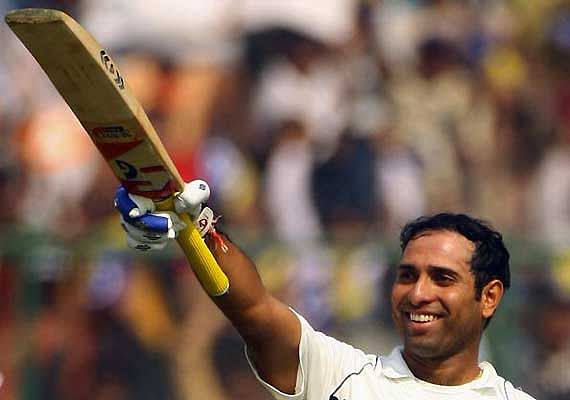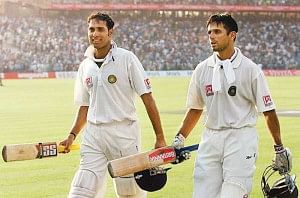
The last of the gentlemen - A personal history
You are not a cricket aficionado. You used to be something of the sort. At a time when batsmen’s willows would be emblazoned with the stickers of cigarette brands. When Super Overs and the Royal Challengers Bangalore (tobacco’s challenge to alcohol as the sportsman’s vice of choice has well and truly petered out) were as yet unheard of. When the men who captained South Asian cricket teams were portly fellows with a sense of impeccable timing. Blame the Coupe de Mondiale of ’98. That was the first sign of conversion, followed by a piece of nifty evangelism by your cousin, who had discovered the multiple levels of delight in staying up for big European nights. So, at the cusp of the millennium, a nine-year-old went from replicating Azhar’s flick through onside to cushioning a weighted ball from central midfield (neither, of course, with success). The point being that when the most accomplished middle order in your country’s cricket history really came into its own, it so happened that you were more interested in when Manchester United were going to get rid of Fabien Barthez.
But, for better or for worse, you are an Indian. By default, you are one of the inheritors of that most agreeable of colonial legacies, the game of cricket. You cannot play it (this piece has already mentioned your lack of success with the onside flick), but you cannot ignore it either. So even as you followed the fortunes of United and Argentina with what can only be described as puritanical glee, you kept one eye on the less vigorous and more drawn out charms of that game of gentlemen. In your country of baffling contradictions and inequities, the only thing most people agree on is the greatness of Sachin Tendulkar. Sometimes, you think that were it not for him, your country of a thousand smaller ones would have met the fate of the Soviet Union. Yes, you are the kind who ascribes grand designs on sport. Who sees the quiet retirement of two gentle, humble South Indian batsmen as some sort of cultural touchstone in the trajectory of your country’s history. Which also explains why you are never taken seriously.
But no amount of seminars on Sport and Society can ever capture how Vangipurapu Venkata Sai Laxman and Rahul Sharad Dravid make you feel. That is more likely to be revealed when you’re batting two down. Here of course, you are referring to quarts of Old Monk Rum. An aimless wastrel like you can afford such excesses. After all, you don’t have to bat out a dozen or so overs in dying light to save a Test match. Nor do have to stand sentinel at slip, all day, for something that might be edged in the last over of play, and hold on it. You, Sir, don’t have to die so that others may live.
You have watched just one live Test match in your whole life. India vs. South Africa, February 2000. At that stadium by the sea in that city by the sea. The Wankhede. You were a month away from turning nine. Yet, there are images from the match that remain seared in your memory. Donald sticking his tongue out at your little party as you chanted “Donald Duck, Donald Duck”. Nicky Boje’s wave that you, in the folly of your youth, believed was meant only for you. Did you say images? Not just images, then. There are also sounds. The collective roar of a city when its hero came out to bat, looking heavenward (still, after all these years, you find comfort in that sight. You are not alone). But more than all of this, you hear the definitive “takk” when Dravid’s willow hit Donald’s leather on a track that curiously, in your country at least, didn’t have much in it for the batsmen. This was the period when Laxman would open the batting for India. Just one of his many compromises. Just another instance of him biting the bullet. Jaffer was dismissed cheaply in the first innings, and in walked Dravid. It was quite a struggle. Donald, Pollock and Kallis were breathing fire. But you still remember the two of them. Trying hard to stay in the middle. Left foot forward, head down, and the inevitable “takk”.
The Hyderabadi has always been more of a magician. Like that other Hyderabadi you tried to imitate in underarm games in a dusty building compound, this one was also quite a stylist. “Wristy” has been an adjective often used to describe batsmen from that most truant of princely states: Jaisimha, Azhar and then of course, Laxman. Again, ironically, you must rely on an image to evoke that most fluid of shots in his repertoire: the leg glance. The fielders at square leg and mid-wicket beginning a chase to retrieve the ball from the boundary as he bisected the green between them. His gloves might have been of silk, his helmet a top hat, his bat a wand. He normally reserved his greatest shows for the Australians, his gentle caresses a sharp contrast to the gum-chewing bludgeoning of a Matty Hayden. It was pointed out that he was sometimes lazy, but can art be hurried? In the slip cordon, he was only surpassed by his good friend Dravid, his big, reassuring hands safely cradling the ball more often than not. He never really adjusted to the one-day game, so the frenzy of the slam-bang T20 format was a far cry. His tricks were more elaborate, suited to the longer and purer form of the game.
Rahul Dravid, on the other hand, was a workman. He did not make batting look easy. Laxman made it look like anyone can do it. Dravid made it look like no one can. Simon Barnes, in the Meaning of Sport, writes of the 1974 World Cup final when the coldly efficient Germans grinded out a win over Cryuff’s freewheeling, Total Football-playing Dutchmen. Then, “method beat madness: prose beat poetry: logic beat intuition: science beat art: the respected beat the beloved.” These very words could be used to describe the outstanding thing that is the career of Rahul Dravid. You can imagine the top executives at Apple at a training program for new recruits, exhorting them to ask themselves at every stage, “How would Steve do it?” If you had your way, every coach in every cricket school in the country should be telling his wards to ask themselves, “How would Rahul do it?” In gullies and mohallas around the country, Dravid is a metaphor for a slow scoring rate, a laborious batting style. But in the shorter forms of the game too he has proved his worth. But he is not the kind of man to ask for the recognition he deserves. He’d rather put his head down, and grind out another one of those centuries.
You, predictably, will end this piece with an image. You can see it in your mind’s eye. It is a balmy Sunday morning in Bangalore. The fourth day of an India-Australia Test. At the house of Rahul Dravid in Indiranagar, two men are relishing freshly made khara bath and chutney. Outside in the driveway, Samit Dravid and Sarvajit Laxman are taking turns to bat and bowl. Dravid’s car waits to take the two men to the Chinnaswamy, where Australia look likely to wrap up the Test match by the second session. Just as steaming hot filter coffee is brought to the dining room, they will not resist reminiscing about a Test match that was played in the summer of 2001. The artist and the workman, the last of the gentlemen, will remember Eden Gardens.